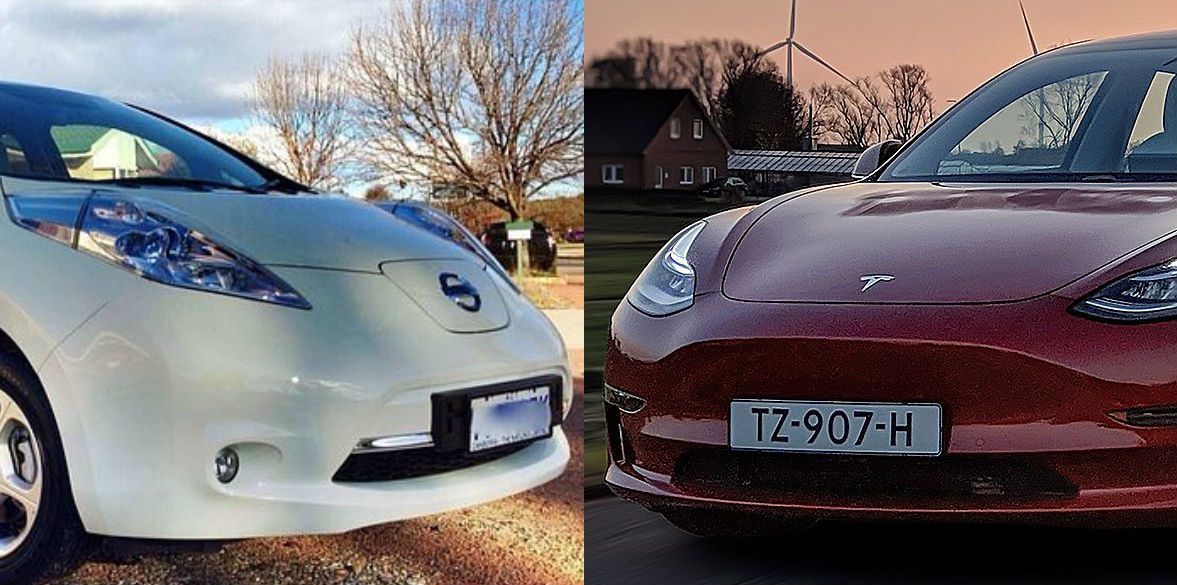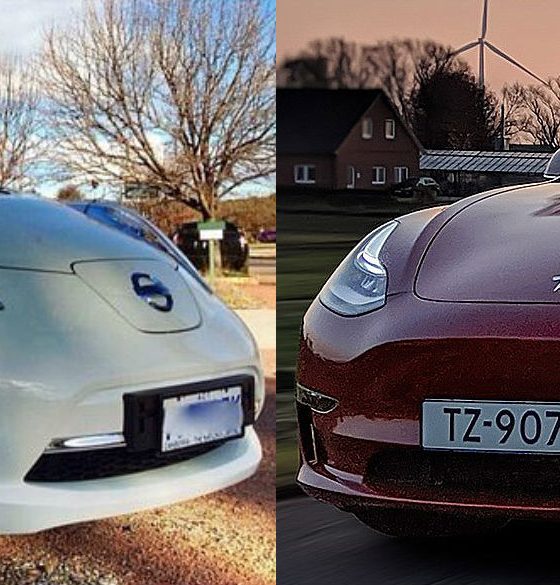

News
Nissan Leaf owner looks to buy Tesla Model 3 after battery invoice nightmare
A longtime Nissan Leaf owner and electric car enthusiast from Australia is looking to purchase a Tesla Model 3 for his next vehicle, following an unpleasant experience surrounding his present EV and a painfully large invoice for a battery replacement.
Canberra engineer Phillip Carlson has been a supporter of electric cars for a long time. This is why in August 2012, he took delivery of a first-generation 24 kWh Nissan Leaf, which he purchased for AU$53,500 (around $35,800). He enjoyed the vehicle and its electric propulsion, though he noticed that he was not getting the range advertised by the Japanese carmaker. Such was expected during winters, but even with regular use, it proved difficult to hit the vehicle’s rated 135 km (84 miles) of range.
Carlson submitted a series of complaints about his vehicle to his dealership over the Leaf’s warranty period, though he was periodically informed that there was nothing wrong with his car. Still, the range issues remained. By 2017, five years after the vehicle was bought, the Leaf was struggling to reach 60 km (37 miles) per charge. The EV enthusiast persisted in his complaints, and earlier this year, it appeared that the dealership finally looked into the issue seriously. “That was the first time they bothered looking at it after I complained so much,” he said in a statement to The Daily Mail Australia.
As it turned out, Carlson’s Leaf actually needed a battery replacement. The Nissan dealership then opted to address the issue, but for a very hefty price. The electric car advocate received an invoice for AU$33,385 (around $22,300) for a full battery replacement for his 7-year-old Leaf. The charge was quite cruel, especially since a 24 kWh first-generation Leaf could be acquired for just about AU$12,000 (around $8,000) in the second-hand Australian auto market.
In a statement to the Australian publication, a Nissan spokesperson stated that it is currently working with the Leaf owner to resolve his vehicle’s issues. As for Carlson, he believes that he should not be charged since his Leaf’s problems were not his fault. The EV enthusiast argued that much of his vehicle’s battery issues were due to Nissan’s design, which lacks ample cooling systems.
Yet, despite his unpleasant experience with his Leaf, Carlson stated that he has no intention of buying a non-electric vehicle. The engineer noted that his next car will definitely be all-electric — it just won’t be a Leaf. Instead, he is looking to purchase a Tesla Model 3, which has more range and has ample cooling for its hefty battery pack. Carlson is also more optimistic about Tesla as the company has extensive experience with electric cars and how they are evaluated and handled.
“Given my time again I’d prefer to hold off buying the Nissan and buy the new Tesla Model 3. Much better range, better support and built by a company that seems to actually care about customers and design their batteries to be (liquid)-cooled. That was the biggest problem with Nissan, even the new model Nissan Leaf still doesn’t water cool the battery,” Carlson said.
Nissan’s treatment of his vehicle’s issues might have been a nightmare, but ultimately, Carlson still considers the small, humble Leaf as a “fantastic” car. “Even as terrible as Nissan has treated me, the Nissan Leaf is still a fantastic car; it’s just that I can’t drive it very far anymore. Just to be clear, I am still a fan of electric vehicles but Nissan has done a terrible thing here,” he said.
H/T Glen Keating.

Elon Musk
Delaware Supreme Court reinstates Elon Musk’s 2018 Tesla CEO pay package
The unanimous decision criticized the prior total rescission as “improper and inequitable,” arguing that it left Musk uncompensated for six years of transformative leadership at Tesla.

The Delaware Supreme Court has overturned a lower court ruling, reinstating Elon Musk’s 2018 compensation package originally valued at $56 billion but now worth approximately $139 billion due to Tesla’s soaring stock price.
The unanimous decision criticized the prior total rescission as “improper and inequitable,” arguing that it left Musk uncompensated for six years of transformative leadership at Tesla. Musk quickly celebrated the outcome on X, stating that he felt “vindicated.” He also shared his gratitude to TSLA shareholders.
Delaware Supreme Court makes a decision
In a 49-page ruling Friday, the Delaware Supreme Court reversed Chancellor Kathaleen McCormick’s 2024 decision that voided the 2018 package over alleged board conflicts and inadequate shareholder disclosures. The high court acknowledged varying views on liability but agreed rescission was excessive, stating it “leaves Musk uncompensated for his time and efforts over a period of six years.”
The 2018 plan granted Musk options on about 304 million shares upon hitting aggressive milestones, all of which were achieved ahead of time. Shareholders overwhelmingly approved it initially in 2018 and ratified it once again in 2024 after the Delaware lower court struck it down. The case against Musk’s 2018 pay package was filed by plaintiff Richard Tornetta, who held just nine shares when the compensation plan was approved.
A hard-fought victory
As noted in a Reuters report, Tesla’s win avoids a potential $26 billion earnings hit from replacing the award at current prices. Tesla, now Texas-incorporated, had hedged with interim plans, including a November 2025 shareholder-approved package potentially worth $878 billion tied to Robotaxi and Optimus goals and other extremely aggressive operational milestones.
The saga surrounding Elon Musk’s 2018 pay package ultimately damaged Delaware’s corporate appeal, prompting a number of high-profile firms, such as Dropbox, Roblox, Trade Desk, and Coinbase, to follow Tesla’s exodus out of the state. What added more fuel to the issue was the fact that Tornetta’s legal team, following the lower court’s 2024 decision, demanded a fee request of more than $5.1 billion worth of TSLA stock, which was equal to an hourly rate of over $200,000.
Delaware Supreme Court Elon Musk 2018 Pay Package by Simon Alvarez
News
Tesla Cybercab tests are going on overdrive with production-ready units
Tesla is ramping its real-world tests of the Cybercab, with multiple sightings of the vehicle being reported across social media this week.

Tesla is ramping its real-world tests of the Cybercab, with multiple sightings of the autonomous two-seater being reported across social media this week. Based on videos of the vehicle that have been shared online, it appears that Cybercab tests are underway across multiple states.
Recent Cybercab sightings
Reports of Cybercab tests have ramped this week, with a vehicle that looked like a production-ready prototype being spotted at Apple’s Visitor Center in California. The vehicle in this sighting was interesting as it was equipped with a steering wheel. The vehicle also featured some changes to the design of its brake lights.
The Cybercab was also filmed testing at the Fremont factory’s test track, which also seemed to involve a vehicle that looked production-ready. This also seemed to be the case for a Cybercab that was spotted in Austin, Texas, which happened to be undergoing real-world tests. Overall, these sightings suggest that Cybercab testing is fully underway, and the vehicle is really moving towards production.
Production design all but finalized?
Recently, a near-production-ready Cybercab was showcased at Tesla’s Santana Row showroom in San Jose. The vehicle was equipped with frameless windows, dual windshield wipers, powered butterfly door struts, an extended front splitter, an updated lightbar, new wheel covers, and a license plate bracket. Interior updates include redesigned dash/door panels, refined seats with center cupholders, updated carpet, and what appeared to be improved legroom.
There seems to be a pretty good chance that the Cybercab’s design has been all but finalized, at least considering Elon Musk’s comments at the 2025 Annual Shareholder Meeting. During the event, Musk confirmed that the vehicle will enter production around April 2026, and its production targets will be quite ambitious.
News
Tesla gets a win in Sweden as union withdraws potentially “illegal” blockade
As per recent reports, the Vision union’s planned anti-Tesla action might have been illegal.

Swedish union Vision has withdrawn its sympathy blockade against Tesla’s planned service center and showroom in Kalmar. As per recent reports, the Vision union’s planned anti-Tesla action might have been illegal.
Vision’s decision to pull the blockade
Vision announced the blockade in early December, stating that it was targeting the administrative handling of Tesla’s facility permits in Kalmar municipality. The sympathy measure was expected to start Monday, but was formally withdrawn via documents sent to the Mediation Institute and Kalmar Municipality last week.
As noted in a Daggers Arbete report, plans for the strike were ultimately pulled after employer group SKR highlighted potential illegality under the Public Employment Act. Vision stressed its continued backing for the Swedish labor model, though Deputy negotiation manager Oskar Pettersson explained that the Vision union and IF Metall made the decision to cancel the planned strike together.
“We will not continue to challenge the regulations,” Petterson said. “The objection was of a technical nature. We made the assessment together with IF Metall that we were not in a position to challenge the legal assessment of whether we could take this particular action against Tesla. Therefore, we chose to revoke the notice itself.”
The SKR’s warning
Petterson also stated that SKR’s technical objection to the Vision union’s planned anti-Tesla strike framed the protest as an unauthorized act. “It was a legal assessment of the situation. Both for us and for IF Metall, it is important to be clear that we stand for the Swedish model. But we should not continue to challenge the regulations and risk getting judgments that lead nowhere in the application of the regulations,” he said.
Vision ultimately canceled its planned blockade against Tesla on December 9. With Vision’s withdrawal, few obstacles remain for Tesla’s long-planned Kalmar site. A foreign electrical firm completed work this fall, and Tesla’s Careers page currently lists a full-time service manager position based there, signaling an imminent opening.








